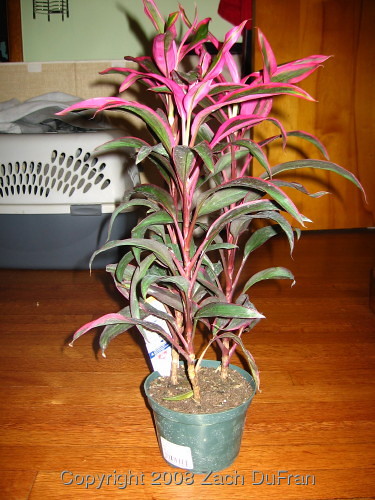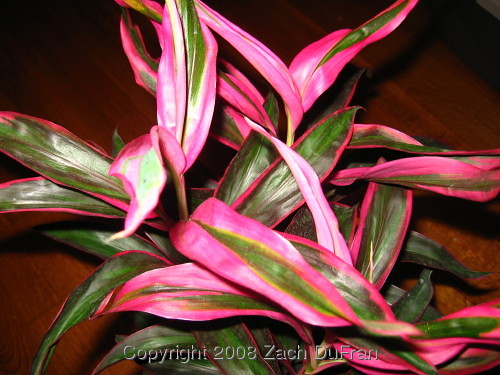A couple of years ago my (lucky) parents went on vacation to Hawaii. They returned with two cane cuttings for me to try and start. The first plant was a
Plumeria, which grew quite easily (after a slow start) from it's cutting. The other plant was a Ti plant (
Cordyline), which did not grow and eventually rotted, I believe. My mom brought back one of each for herself as well and had the same luck as I did. Ever since, I have looked admiringly at Ti plants, wondering "what if...?"
 |
| My new Ti Plant - Cordyline sp. |
Usually Lowe's gets Ti Plants during the summer season and has them in big 8-12" pots for $10-20 a piece. Never wanting to spend that much money, I haven't bought one before. But just recently I ran across a 6" pot at Lowe's with three separate shoots of Ti plant for only $3.99.
 |
| Cordyline foliage coloring (pink, green and dark green/red) |
I think this plant is probably a different species from the cane cutting brought back from Hawaii, since the stalk of this plant is much smaller. But it could just be that this is a younger plant.
I haven't been able to get a correct species ID on this plant yet. The leaves are much more slender than the common
Cordyline terminalis and
Cordyline fruticosa. Maybe all that will change with maturity, though.
Any ideas?


Sorry I can't help with the id, but it is a beautiful plant. And you got it for a great price. I love our Lowes, they have some wonderful plants.
ReplyDeleteAs best as I've been able to determine while working on the Cordyline terminalis profile (posting next Thursday! Don't miss it!), all ti plants are of the same species, but there's disagreement about whether it's more correctly called terminalis or fruticosa. Terminalis is in the majority, but fruticosa seems to be more favored by the people who care about such things.
ReplyDeleteI've e-mailed the International Cordyline Society (yes, there's an International Cordyline Society) to ask them for a ruling one way or the other, but they've not gotten back to me yet, and don't appear likely to do so.
Thanks for the identification info, Mr Subjunctive!
ReplyDeleteThat is beautiful! I love the pink and green together and that pink almost looks like a "flamingo pink". :-)
ReplyDeleteIf I remember correctly there is a red version(the more traditional) of this plant and a green version(the less traditional). All of the multicolored versions are just hybrids and vary from source to source. by the way, the list of uses of this plant is astounding. Also, if you live somewhere with hard water, use spring water... I went through many leaves before I figured that out.
ReplyDeleteI recently bought one just like your picture & it was called a Kiwi Ti plant
ReplyDelete